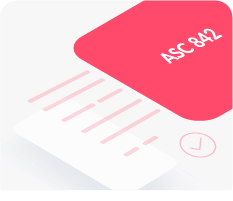
GASB 96 summary: don’t sweat over SBITAs
By
EZLease team
If you’re a governmental organization, you already have a mountain of acronyms to learn. To add to that list, the Governmental Accounting Standards Board (GASB) has written two lease accounting standards you need to consider – GASB 87 and GASB 96. GASB 87 applies to most lease types and is covered in more detail here. This blog focuses on GASB 96 which applies to subscription-based information technology arrangements (SBITAs) as of June 2022.
Here is a summary of what you need to know about GASB 96, SBITAs and the impact on your financial reporting and subscription terms.
What is GASB 96?
GASB 96 is a set of accounting standards defining SBITAs for government end users. It governs the accounting and financial disclosure of cloud-based software subscription payments. Before GASB 96, there was no specific accounting guidance for an SBITA. To the extent relevant, the standards for SBITAs are based on the standards established in Statement No. 87, Leases, as amended.
GASB 96 does the following:
- Establishes a standard requiring governmental organizations to keep track of SBITA statements
- Establishes the existence of an intangible right-to-use asset and a matching subscription liability resulting from an SBITA agreement
- Provides capitalization requirements for things like implementation
- Defines the subscription term as the time the lessee has an irrevocable right to use the basic IT assets
- Defines the disclosure requirement for SBITAs
How do I determine the subscription term for SBITAs?
The subscription term is the non-cancellable period during which you have the right to use the underlying asset. The term also includes the option to extend or the option to terminate the contract based on reasonable certainty.
GASB provides an exception for short term SBITAs. These are contracts which are 12 months or less, including any options to extend, regardless of the option will be exercised or not. Subscription payments for short-term SBITAs would be recognized as outflows of resources over subscription term.
How is the subscription liability and subscription asset measured and subsequently accounted for?
Subscription liability is initially measured as at the present value of subscription payments expected to be made during the subscription term. Future subscription payments should be discounted using the implicit rate if it is readily determinable or the incremental borrowing rate. You should recognize amortization of the discount on the subscription liability as an outflow of resources (for example, interest expense) in subsequent financial reporting periods.
The subscription asset would be recognized and initially measured as:
- The sum of the initial subscription liability amount,
- Plus payments made to the SBITA vendor before commencement of the subscription term,
- Plus implementation costs eligible to be capitalized,
- Less any incentives received from the SBITA vendor at or before the commencement of the subscription term.
The subscription asset should be amortized and recorded as an outflow of resources over the subscription term.
Setup, payments, modifications, and terminations of SBITAs are essentially identical to leases. Modifications that result in a reduction of the right to use IT assets (specifically including either a reduction in the assets or a shortening of the term) are treated as partial terminations, in which the asset and liability are reduced, and a gain or loss recognized for the difference between the two. This is the same as for GASB 87.
Who has to comply with GASB 96?
GASB 96 applies to the senate, local governments, and government agencies using Generally Accepted Accounting Principles (GAAP). Any of these entities involved in subscription-based payments for information technology software should be aware of GASB 96.
What do I have to disclose under GASB 96?
As a governmental organization, you should report SBITAs’ information in your financial statements for categorization and disclosure purposes. The stipulation requires that you:
- Provide a basic summary of its SBITAs — the foundation, terms, and circumstances for determining variable payments not contained in the subscription liability measurement
- Report subscription assets and associated accrued amortization separately from other capital assets.
- Record the percentage of resource outflows in the variable payment reporting time that you did not earlier include in the subscription obligation measurement.
- Recognize extra termination penalty and other payments not formally calculated as the subscription liabilities in the reporting phase
- Show the subscription liability’s principal and interest obligations to maturity separately for each of the five succeeding fiscal years and in five-year increments afterward.
- Make SBITA commitments before the start of the subscription term.
- Report any loss associated with faulty components
How does implementing GASB 96 affect my financial statements?
GASB 96 is required to be adopted for fiscal years starting after June 15, 2022. Earlier adoption is also permitted. The standard should be adopted retrospectively by restating financial statements, if practicable, for all prior fiscal years presented. If restatement is not practicable, then you should report the cumulative impact of adoption by restating the beginning net position for the earliest fiscal year. Subscription assets and liabilities should be recognized and measured based on the facts and circumstances at the beginning of the fiscal year in which the standard is implemented.
How is GASB 96 different from GASB 87?
GASB 96 is a modified version of GASB 87, approved by GASB in June 2017. A few distinctions exist between the two standards, as follows:
- Terminology: GASB 87 specifies terms for leasing agreements, while GASB 96 specifies SBITAs.
- Capitalization of SBITAs implementation expenditures: Vendors incorporate certain costs into the subscription asset and spread throughout the contract life in the GASB 96. However, the term does not exist for leases, only direct costs in GASB 87.
- Presentation of the balance sheet with footnote disclosures: The information disclosed validates both standards. Nevertheless, individual footnotes are necessary for leases and SBITAs since the balance sheet reflects the asset/liability balances in specific line items.
It is possible to implement both standards simultaneously regardless of the variations, which require slightly different procedures.
SBITAs and leased tangible assets share a few similarities.
- The asset and liability balances use similar calculations: GASB 87 and GASB 96 derive liability from the current value of the outstanding payments in GASB 87 and GASB 96, while liability emanates from comparable assets.
- Funding structure and organization: The standards accommodate the exact organizational structure, funding, and user responsibilities.
- Stable successive accounting: Both standards account for regular contract activity in the same way. Their accounting terms handle terminations, modifications, impairments, and other contract changes in the same manner.
How will GASB 96 improve my financial reporting?
GASB 96 improves financial reporting as it will:
- Establish an explanation for SBITAs and offer even accounting and financial reporting guidelines for dealings that match that description, standardizing financial statements across organizations.
- Form capitalization standards for execution expenses, making it easier to compare reporting across organizations.
- Improve the relevance, trustworthiness, and transparency of your financial statements.
- Help assess a government’s duties and assets resulting from SBITAs by understanding the scope and significant components of its SBITA activity.
How can I prepare for GASB 96?
We know that most governmental organizations are tight on resources and are facing adoption across multiple lease accounting standards (as well as many other acronym-based projects). Starting the process as soon as possible will make it easier to get compliant. EZLease is ready to help you simplify and meet GASB 96 requirements, whether you take on the project yourself or need outside help. Get started today with a free trial.



